“New York, You’ve Changed” is a Scouting NY feature in which the New York depicted in classic movies is compared with the city of today, a full shot-by-shot dissection to see what once was and what has changed. Check out North By Northwest Part 1 here!
Continuing where we left off, Thornhill is abducted and taken to Old Westbury (the horror!). The car turns off Old Westbury Road…
…and heads for the Townsend estate:
Where are we actually?
Old Westbury Gardens, of course!
Old Westbury Gardens was built by US Steel heir John Shaffer Phipps in 1906 for his new wife Margarita. Today, the estate is open to the public, and I highly urge you to go if you’ve never been. The interior is amazing and the gardens are absolutely gorgeous.
Old Westbury Gardens has played a roll in a number of movies, from Love Story to To Wong Foo to American Gangster. The goon car pulls up…
…and Thornhill is brought inside…
…to a movie set that looks nothing like Old Westbury Gardens. Personally, I really, really wish Hitchcock didn’t rely so heavily on studio sets, as if they were interchangeable with the real thing. He clearly preferred the heightened level of control, but I think his films suffer for the choice, especially when compared with the energy his on-location work exudes.
We hit a brief stretch of not-on-location locations. I don’t think you need me to point out that the road Thornhill is sent drunkenly down is not in New York:
The police cars may say Glen Cove, but I’m betting this was filmed in California as well:
Trying to prove that he’s not crazy, Thornhill and his mother (played by Jessica Royce Landis, who was actually younger than Grant) investigate the Plaza on what is assuredly a movie set:
Ditto the hotel room:
Back to New York City again! Following a hunch, Thornhill heads for the United Nations where Lester Townsend is scheduled to speak:
The production was unable to get permission to film at the UN, so they cheated it in a few different ways. The brief shot of Thornhill exiting the cab is backdropped:
However, the shot of Thornhill going up the stairs is the real deal. Hitchcock and crew hid in a van parked across the street and covertly grabbed the shot (praying, of course, that no one started gawking at Grant):
The interior of the UN was achieved through matte paintings and studio sets (though I really appreciate that they included the 59th Street Bridge out the window):
Now under suspicion of murder, Thornhill flees to nearby Grand Central to hop a train to Chicago. You’ll notice one major difference in this comparison shot. On the left, just open space…
Today, a staircase!
Grand Central was always intended to have twin staircases, but for some reason, the eastern one was never built. It was only added during restoration work in the mid-90s.
Thornhill has a discreet phone conversation in a pair of phone booths I imagine were added for the filming:
You would not believe how many people actually used this mailbox while I was trying to take this picture:
Thornhill exits the booth, highly suspicious of everyone around him. Can someone explain why the different colors in brickwork are so contrasted here? Is it a filter?
Two cops watch diligently at the famous Information Booth:
Today, things are a bit more modern:
Thornhill hurries across the terminal to the ticket booth windows…
“New York Central System” has been replaced by “MTA Metro-North.”
Thornhill goes up to Window 15 to buy a ticket:
The windows have since been renumbered, but if you’d like to buy a ticket at the same window as Cary Grant, just go to #6:
Thornhill orders a ticket from a teller – and suddenly, we’re in movie set land again!
Let’s compare it anyway. It blows my mind that so many minor sets were built when you were already on location at the real damn thing, but 1957 was a different time.
He turns around – and Thornhill is gone! This is backdropped, of course…
Thornhill makes his way to the western set of track entrances…
And finally, boards a train:
I want to believe that someday, we’ll be as nostalgic for this style of train – but for some reason, I doubt it.
From there, it’s on to Chicago – and adventure!
-SCOUT




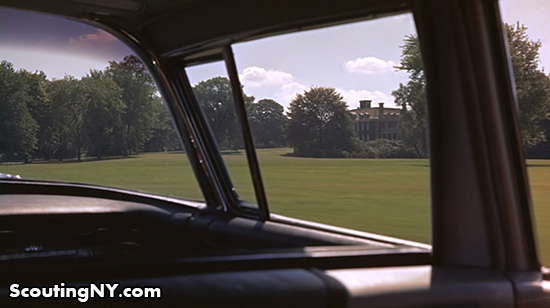


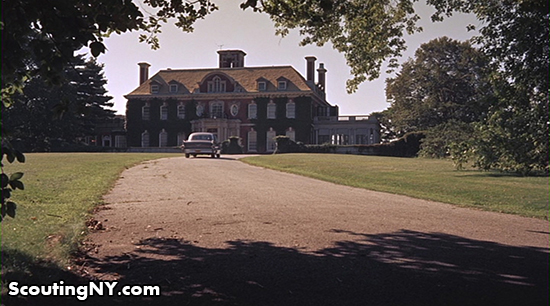
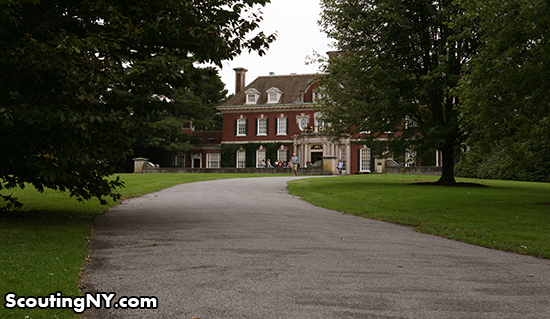
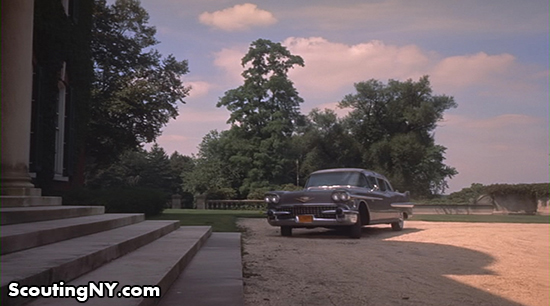
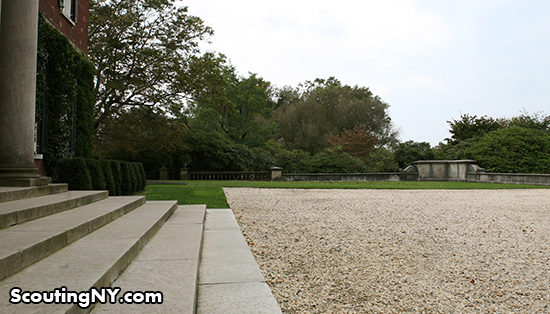

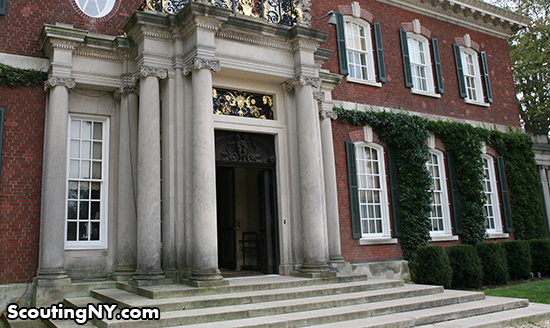

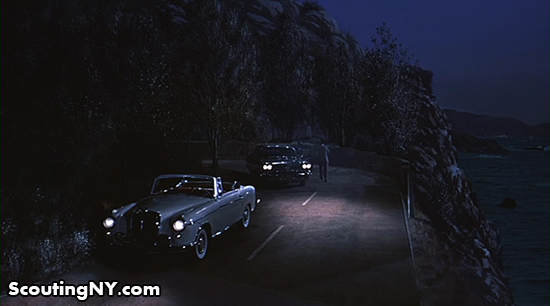
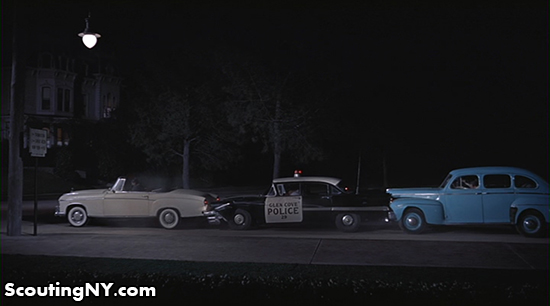


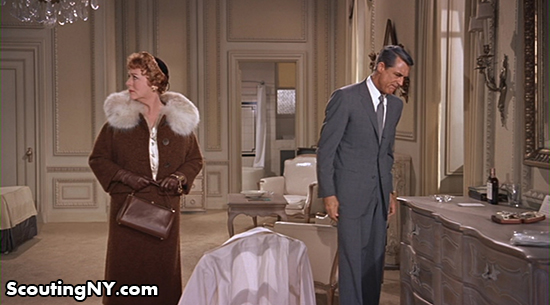
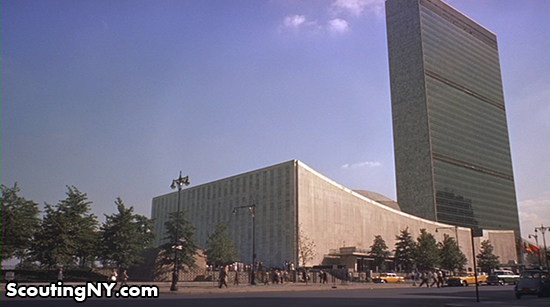

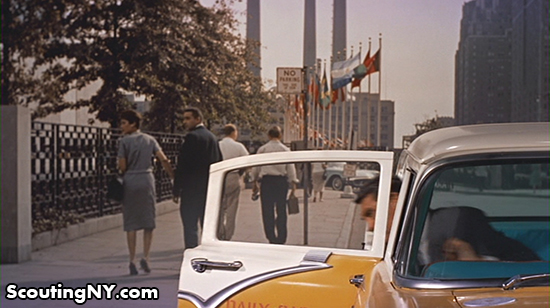

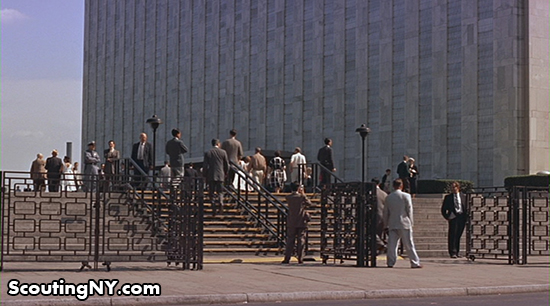
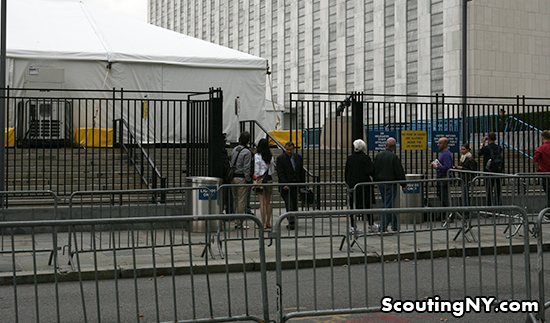


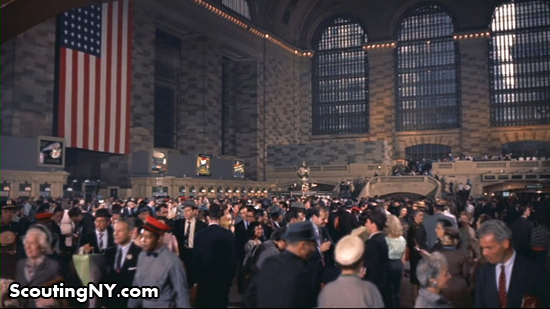

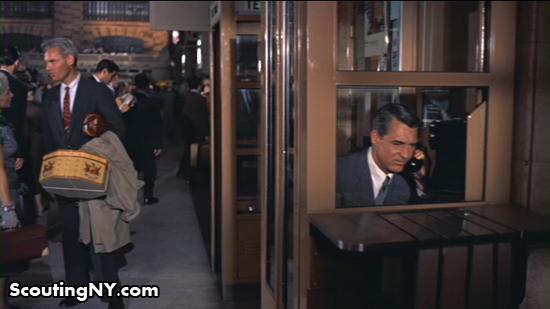
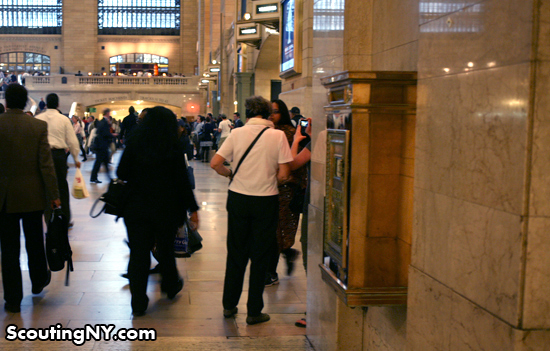
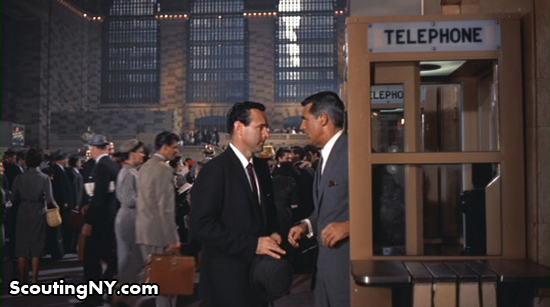

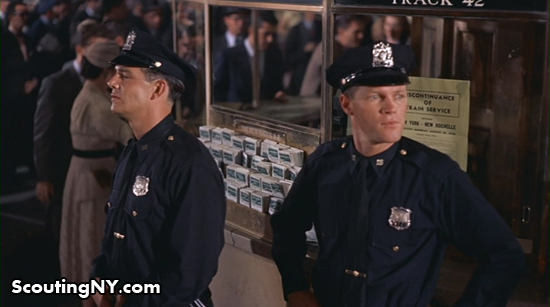
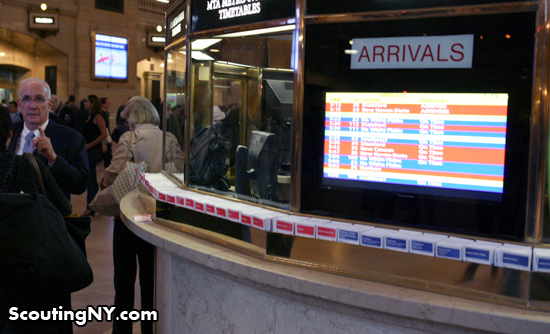

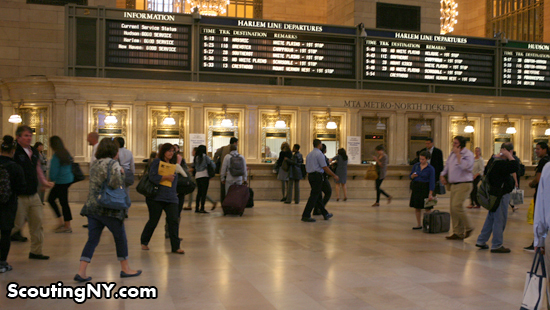
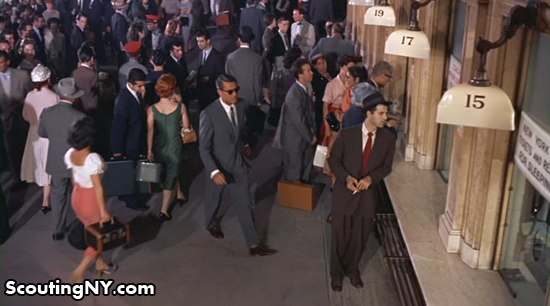
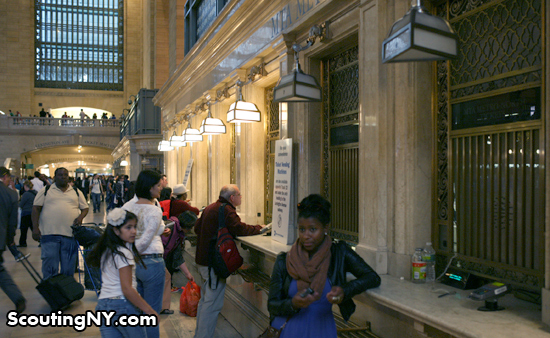

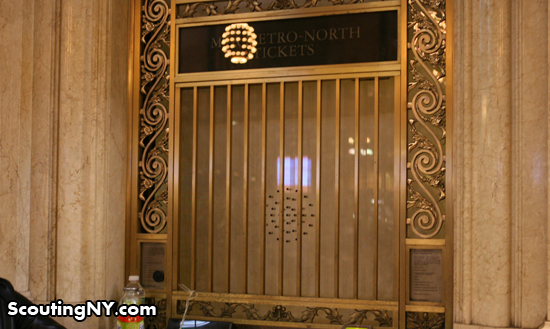

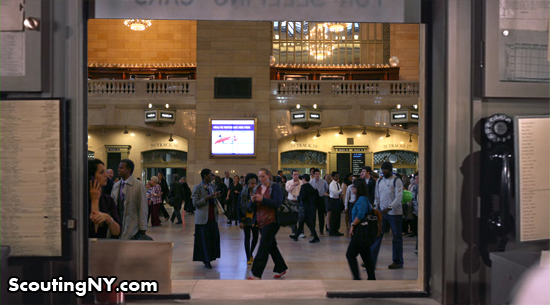

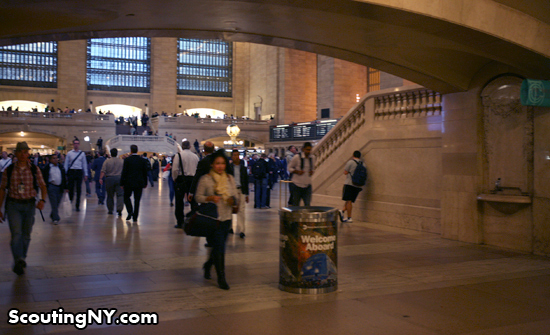
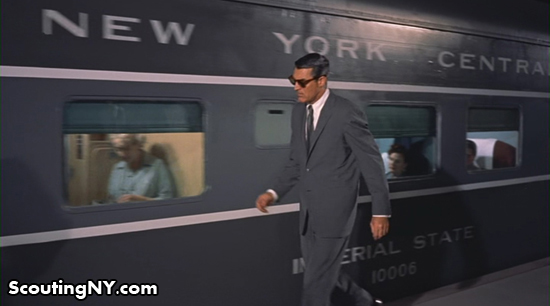
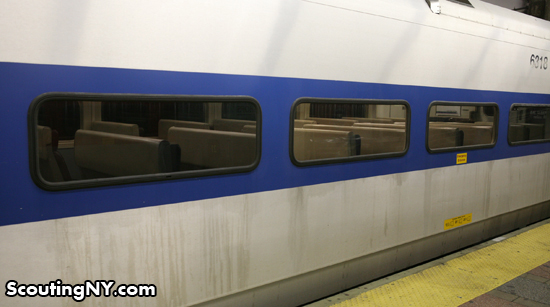
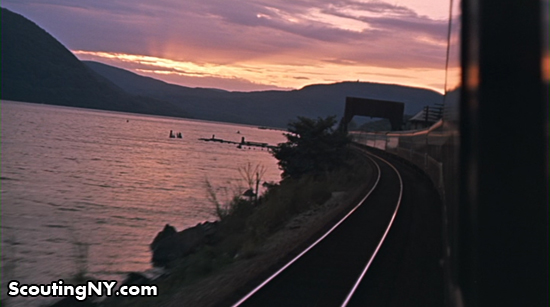

A great post as always. One thing you don’t show — which I’m sure has changed (if it ever actually existed) — is the red carpet on the train platform in the film with “20th Century Limited” emblazoned on it. This amazes me every time I see the movie.
I’ll have to see the movie again, but one way to guarantee Cary Grant wasn’t recognized going up the UN steps would have been to use a body double.
True, but listen to either the commentary or the DVD documentary and someone confirms it was Grant and they got it in one take, with Hitchcock crowded into a van.
The brass ornamentation on the ticket windows only appears to be there in the modern shots, and not in any from the film. I’m guessing that was added in the restoration/renovation as well. The ticket booth shots from the film also seem to match up pretty well with one another. Maybe that scene was shot on location after all.
The contrasting stone colors are a product of the great amount of soiling that was on the building before its restoration and cleaning. Architects often used to use different types of stone that were similar in color to give the building more texture. However, those stones can react very different to soiling- hence why some are so dark while others are much lighter. Now that the building’s been cleaned, you can’t see the difference, but if it were to remain untouched, the same pattern would again develop over time.
Love the blog, and I love this series! Especially since you’ve chosen a Hitchcock film this time- I’m a big fan 🙂 Keep up the great scouting!
Hi, Scout–were you in NYC when there was a big exhibition in Grand Central’s main waiting room area of NYC-related movie paraphernalia? They actually had hanging one (two?) of the huge paintings used for interiors–the UN one was for Roger O. Thornhill (“What’s the O stand for?” “Nothing.”) walking towards the elevators. Even standing right up close to them, it was amazing how realistic they looked!
That’s awesome, wish I had seen it.
This was it:
http://www.nytimes.com/2007/05/25/movies/25cell.html
Not only would shooting in the real Oak Bar or railroad ticket booth be disruptive to business, but there are also cinematic reasons to build sets instead.
The Vistavision camera was huge, and the lights of the time were similarly oversized. Without removable walls, camera placement in a small space becomes very difficult. http://cdn.hometheaterforum.com/6/64/64c9fe0b_vv.jpeg
Today both cameras and lights are a lot smaller and easier to place.
Different times Scout. Check out the clothing styles in 1957 and currently. Altho I am not a great fan of ’50’s style I am a fan of style itself. I will admit to passing thru GCT in jeans and running shoes but you can rest assured that when I am visiting the Campbell Apartment that I will be better clothed.
We have a few mailboxes very similar to those in the lobby of my office building (the Monadnock Building in Chicago, built in 1891 and 1893). People use them a lot, actually! Heck, he have those great old drop slots leading down to them from all the way up to the top floor on 16. The building is otally worth checking out if you’re ever in Chicago. http://en.wikipedia.org/wiki/Monadnock_Building
Re: the brickwork: you can look at Hal Morey’s classic Grand Central from the 1930s and see the same higher-contrast brickwork.
And from my memories of Grand Central in the 1970s, the brickwork was particularly two-toned then.
Grand Central today is much brighter than it was pre-renovation, and so the subtle color contrast is not as noticeable. The main concourse was covered with advertisements, and the windows were not only dirty but still had some blackout paint from World War II that was not finally removed until recently.
The main culprit though is probably that haze present in stills from the film: cigarette smoke. Too bad there aren’t any clear shots of the ceiling, because it was completely covered in tar that was discovered to be from cigarettes. There’s still a small uncleaned square showing how filthy the ceiling and masonry was.
Do the current ticket booths still have those dial wall phones? Or did you superimpose the movie ticket booth over the current GCT?
Great posts! I used to speed walk through GCT from the Shuttle to Lex, on my way to work at 3rd and 43rd. At 8:30 AM it was an obstacle course and fun to navigate, but still quicker than dodging the crowds on the sidewalks.
I recognize Cary Grant’s ‘mother’ as his future mother-in-law from To Catch a Thief. She has one of most-favorite movie lines ever (well, two actually) when she is at the bar during the big mask ball scene and she asks the bartender “Avez-vous bourbon?” I die every time. She played the dry/sassy American so well. (The second line is when she and Grace Kelly are fighting and she says to Grace “Sit down before I knock you down!”. Imagine saying that to Grace Kelly!)
I also recognize the ticket agent at the window as Ned Glass who played across from Cary Grant in Charade (a FABULOUS movie that is criminally overlooked).
I love how you pay such attention to the details of these films. Your spin and additional knowledge really bring them to another level of enjoyment for me.
Maybe this was not the case back then but wouldn’t a train to Chicago leave from Penn and not GCT being the commuter station?
New York Central trains to Chicago used Grand Central for what was called the “water level route.” This route passed through Albany, Buffalo, Cleveland and so on. Back in the days of steam locomotives it allowed for much faster speeds than the Penn Station routes as it didn’t have long upgrades through the Appalachians. This advantage didn’t apply so much by the time of the movie, after the switch to diesel locomotives, but the route remained popular.
One of my all-time favorite films. And I agree, Hitchcock’s fetish with stage sets really bothers me. It’s not too noticeable here, but by Marnie, say, it feels studied and tired, and really intrudes on the film.
As Peter notes, Grand Central was originally an intercity and commuter terminal. Intercity trains departed on the main level, while commuter trains used the lower level, although a number of those left from the main level as well. Arriving intercity trains had their own set of tracks and waiting area – today, it’s the room off to the northwest of the main floor, with the giant newsstand in the middle, and the old arrivals board on the West wall. After Amtrak, almost all intercity trains switched to Penn Station, but Amtrak and the trains up the Hudson to Albany and Montreal stayed at Grand Central into the 80’s, when they finished a connection from Penn Station to the old NYC West Side freight line, after the High Line below Penn Station was abandoned.
FYI, the crumpling police car in the scene above was specially fabricated by LA car customizer George Barris, with lightweight aluminum replacing the sheet metal.
These are awesome, but whatever happened to the film from our Labor Day homework last year? I keep waiting to see that one. Did I miss it?
In the 1950’s as noted GCT was used by the New York Central and Pennsylvania Station was used by the Pennsylvania Rail Road. The Pennsy ran electrics (GG 1’S) thru the Hudson tubes and the Central ran their electrics (box cab types) under Park Avenue and along the Hudson to Croton on Harmon where they switched to diesel. The Pennsy was electrified to Washington. At the time they were both independent companies until the merger that birthed the Penn Central which morphed intp Conrail and is now parts of Norfolk Southern and CSX.
The bricks in GCT are different in the comparison shots due to the extensive cleaning of the station in I believe the 90’s. They left a very small rectangle on the northwest section of the ceiling uncleaned. Cool to see the comparison! Next time your there, check it out!
When it came time to film the climactic scene at Mt. Rushmore, Hitchcock had to use an outdoor set. It wasn’t possible to get permission to film at the real monument and the scene was much too long and elaborate to allow for UN-style “guerrilla” filming.
For the Grand Central scenes it would have been nice if you found a shot where the new open-air Apple store is. People from that times wouldn’t have imagined a computer company having something in that space.
http://bits.blogs.nytimes.com/2011/08/17/bits-pics-inside-apples-upcoming-grand-central-store/
There is a picture of where the Apple store currently is. It’s that picture of Cary Grant heading for the western tracks (it’s the one with the “Parcel Room” sign, looking toward the east balcony. The Apple store is visible in the current day photo, along with the new east staircase that was added in the renovations.
And while no one could have imagined a computer company in that space decades ago, the east balcony was once home to a display by another American technological giant, what could be considered the Apple of their time: Eastman Kodak’s famous Colorama occupied the east balcony for over 3 decades.
Given Hitchcock’s attention to detail, not to mention the fact that this was scarcely a low-budget movie, it’s slightly surprising that he filmed the “Glen Cove” scene on a stretch of the California coastline that looks nothing like the real thing. Another scene where the use of an incorrect location is really obvious is the famous scene with the crop dusting airplane. It’s supposed to be in Indiana, not far from Chicago, but the area is way too arid for anything in the Hoosier State. Hitchcock actually filmed it in central California.
Not having anything to do with anything but the woman who played Cary Grant’s mother in the film was only 8 yrs. older than Cary Grant.
Fantastic post! I wish you’d continued as Grant and Saint headed north on the train – Hitchcock was as accurate with the Hudson River backdrops seen out the train window as he was with the midtown street scenes out the taxi window. You can clearly see them passing under the then-four-year-old Tappan Zee Bridge, for example.
The screen shot under your comment “Now under suspicion of murder, Thornhill flees to nearby Grand Central to hop a train to Chicago. You’ll notice one major difference in this comparison shot. On the left, just open space…” poses one of this movie’s great mysteries: What is ROGER C. CARMEL doing in this shot? Was he an extra or was there a scene involving him that never got into the final cut? He is just to the right of center, one row of people back, earnestly talking to someone.
GREAT SITE!!! Especially your new shots done so painstakingly from the same angles.